Document 1
Excerpts from Memo: Health Rationale for DPMC’s paper on ‘Reconnecting New
Zealanders: Omicron update’.
Proposed changes to pre-departure testing requirement
15. As a result of the rapid spread of Omicron in many countries - and the impact of this
on the availability of COVID-19 testing - there is a need to adjust pre-departure
testing requirements for travellers to New Zealand.
16. Currently, the standard pre-departure testing requirement of a traveller undertaking a
PCR test within 48 hours of beginning their journey to New Zealand only applies to
around 80 jurisdictions where it is generally feasible for travellers to comply with
those requirements. In addition, there are:
1982
a.
105 jurisdictions which are exempt from the standard requirement, and
subject to an alternative testing condition of a RAT or LAMP test within 24
hours of the traveller beginning their journey to New Zealand
Act
b.
21 jurisdictions from which travellers are entirely exempt from the
requirement.
17. There is a consensus among key agencies (including DPMC, the Ministry of Foreign
Affairs and Trade, Ministry of Transport, the Ministry of Business, Innovation and
Enterprise, and New Zealand Customs) that the current arrangements are not
workable in the medium to longer term due to the fluid situation in many jurisdictions.
A more durable approach is required, which retains the benefit of pre
Information -departure
testing in reducing cases at the border, but does not require frequent reassessment
of the feasibility of different testing options in jurisdictions around the world.
18. DPMC is recommending in a paper to the RNZ Ministers' Group on 17 January 2022
Official
that a consistent set of requirements should apply to travel ers from all jurisdictions,
except for a group of 21 jurisdictions which are currently exempt from PDT
requirements. In effect, this would mean that like the 105 jurisdictions exempt,
the
subject to alternative testing requirements, almost all travellers to New Zealand
would be required to undertake either a PCR test within 48 hours of departure, a
supervised RAT within 24 hours of departure or a supervised LAMP within 24 hours
of departure. under
19. It is recommended that you support the DPMC proposal
I recommend that you:
d. Agree to DPMC's proposal that all travellers to New Zealand be required to
Released
undertake either a PCR test within 48 hours of departure, a supervised RAT within 24
hours of departure, or a supervised LAMP within 24 hours of departure.
Document 2
Excerpts from: Briefing: Requirements for the medium-risk pathway
Summary
3. The Cabinet Social Wellbeing Committee (with power to act) agreed the broad
settings for the medium risk pathway on 24 November [SWC-21-MIN-0200 refers],
which were:
a. a negative pre-departure test within 72 hours prior to boarding.
4. The Ministry of Health (the Ministry) has reviewed the medium-risk pathway settings
against operational changes required to respond to Omicron in the community, and
recommends several changes to pre-departure testing and self-isolation
requirements:
1982
a. pre-departure testing requirements for travellers entering both the medium
and high-risk pathways from all countries (except Very High Risk countries)
must provide evidence of:
Act
i. a negative RAT or LAMP test (completed within 24 hours prior to
boarding) or
ii. a negative PCR test (completed within 48 hours prior to boarding).
Recommendations:
c.
Agree that pre-departure testing (PDT) requirements for travellers are
updated to allow evidence of a negative RAT or LAMP test (within 24
Information
hours of departure) or a negative PCR-PDT (within 48 hours of departure)
for travellers entering both the medium and high-risk pathways (except
travellers from very High Risk jurisdictions).
d.
Note that the PDT changes will not apply to travellers who are currently
exempt from PDT requirements, for example travellers from countries
Official
covered by the exemption notice in force under clause 27 A of the
COVID-19 Public Health Response (Air Border) Order 2021.
the
Context
Measures for the medium-risk pathway
1. A suite of measures for the medium-risk pathway have been recommended to
under
mitigate the spread of COVID-19 into the community as we begin to open our border.
These measures and the public health rationale include:
Measure Public health rationale
Pre-
PDT aims to keep as much of the risk offshore as possible. It also aims to
departure reduce the possibility of inflight transmission, even in a situation where the risk
testing
onshore may present a greater risk.
Released
(PDT)
Keeping the risk offshore to the extent possible, and in a way that is
proportionate, allows us to preserve our limited resources, especially in the
event of widespread COVID-19 in the community. A Ministry review of PDT in
early 2021, showed that it can reduce the burden of case arrivals at the
border, in a global context where the prevalence of COVID-19 is rapidly
increasing.
PDT is the first opportunity to screen travellers for COVID-19. Use of a PCR
test (within 48 hours of departure) or a RAT or LAMP test (within 24 hours of
departure) are acceptable for PDT purposes.
Document 2
Pre-departure testing
13. Prior to the emergence of Omicron, a PCR, RAT or LAMP within 72 hours was an
acceptable form of PDT for travellers from most countries.
Current pre-departure testing requirements
14. On 4 January 2022, due to the emergence of Omicron, the Acting Minister for
COVID-19 Response agreed to tighten PDT requirements by limiting the type and
time in which a test had to be taken. This means that currently all travel ers arriving in
New Zealand must have a negative PCR PDT within 48 hours of their scheduled
departure of their first international flights.
1982
15. However, there are 105 jurisdictions where obtaining a PCR test may be difficult or
not possible. As such, an exemption was created for this group of jurisdictions to
allow travellers to provide evidence of a supervised negative rapid antigen tes
Act t (RAT)
or a supervised loop-mediated isothermal amplification (LAMP) test taken within 24
hours of departure. An exemption was also created for 21 low-risk jurisdictions where
testing capacity is limited.
16. These PDT settings are not feasible in the medium-to-longer-term due to the fluid
COVID-19 situation in many jurisdictions as Omicron cases rapidly increase.
Information
17. To meet New Zealand's PDT standards, all tests (including self-administered or at-
home tests) must be processed by a laboratory recognised in the country of origin as
authorised or accredited to conduct tests.
18. I therefore recommend a more durable and pragmatic approach to PDT and
Official
managing the risk offshore. This approach retains the benefit of PDT in reducing
cases at the border but does not require frequent reassessment of the feasibility of
different testing options in jurisdic
the tions around the world.
19. There are several key components that determine the effectiveness of COVID-19
testing, including sensitivity and timeliness.
under
a. PCR tests are performed in a laboratory more sensitive than a RAT or LAMP,
particularly early in the course of infection, however, the typically longer
turnaround times means that it cannot be done close to the time of departure.
With regards to PDT, this creates a longer period that the person could be
exposed to COVID-19 after they've taken the test but before boarding the plane.
PCR testing wil also require many travellers to interact with symptomatic cases
Released
and contacts who are lining up in the same area to get a diagnostic PCR,
depending on the country of departure.
b. RATs are less sensitive than a PCR or LAMP but can be conducted much closer
to the time of departure, creating a much smaller window where people could be
infected after having taken their test. Travellers taking RAT tests may be less
likely to come into contact with symptomatic cases when getting tested.
c. LAMP tests can be performed in a laboratory or at point of care. It is also less
sensitive than a PCR but has the advantages of being more sensitive than a RAT
while stil being able to be performed rapidly.
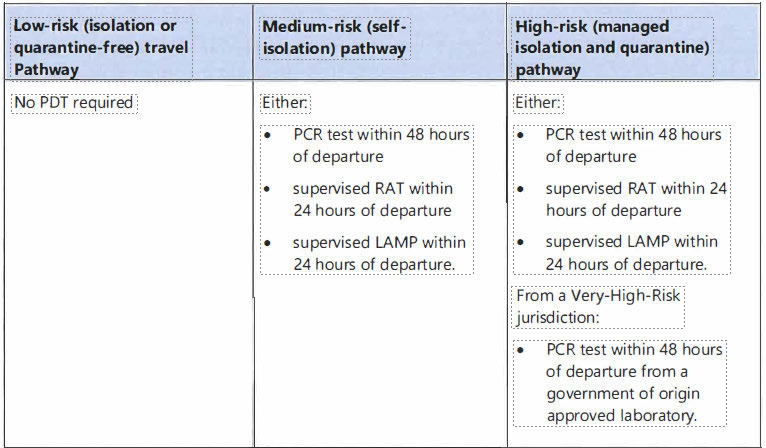

Document 2
20. I therefore recommend that PDT requirements for travellers from all countries are updated
to allow evidence of a negative:
a.
RAT or LAMP test (completed within 24 hours of departure) or
b.
PCR test (completed within 48 hours of departure).
21. As shown below, there will be varying PDT requirements across all pathways:
1982
Act
Information
22. The timing of these updates should be aligned with the commencement of Step 1 of RNZ
Official
from 11 :59pm on 27 February 2022. Exemptions from PDT requirements for travellers from
some countries (for example, relevant low-risk Pacific countries listed as Group 1 countries),
would remain in place. However, the
the exemption notice will be revised to reflect that some
Pacific countries are now no longer considered low-risk.
23. Expanding PDT options also provides more certainty that travellers will be reasonably able to
meet New Zealand's requirements. There have been reports of global testing shortages of
both PCR and RATs. Providing
under additional PDT options for travelers also ensure that there is a
higher likelihood that travellers will be able to access a suitable testing option as supplies
fluctuate or testing modes available in their location.
Appendix 1: Requirements for the <medium Risk Pathways
Released
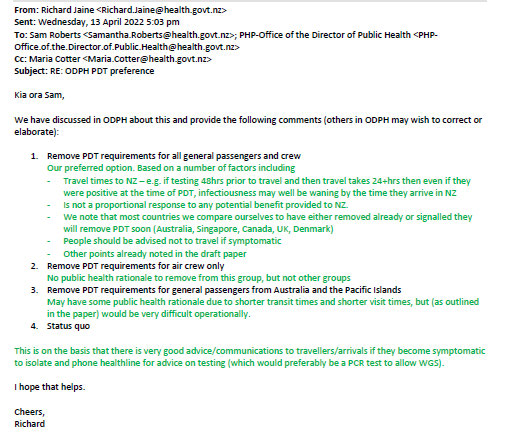
Document 3
Excerpts from: Email correspondence RE: ODPH PDT preference
1982
Act
Information
Official
the
under
Released
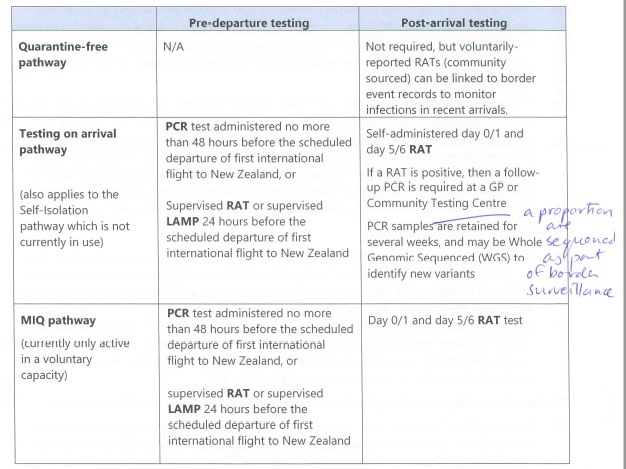
Document 4
Excerpts from: Memo: Review of the testing regime for air arrivals
Current testing regime for arrivals
12. The current testing regime for arrivals, which includes asymptomatic pre-departure
and post-arrival testing, was implemented when we moved to the testing on arrival
pathway, which no longer required arrivals to self-isolate. The purpose of this regime
was to:
a. prevent people with active infection from boarding a flight and inadvertently
infecting other travellers (who may go on to infect others in New Zealand and to
'slow the flow' of cases into the New Zealand community.
b. identify any 'overseas' or 'inflight' infected cases early; undertake PCR testing on
positive RAT tests to contribute to whole genome sequencing (WGS) and early
identification of new variants.
1982
Act
Information
Official
the
under
13. As shown in
Appendix
Released
A: International Comparison Table-Border -Settings,
many jurisdictions still require pre-departure testing (PDT) and forms of post-
arrival testing. However, like us, other jurisdictions are also in the process of
easing their border settings.
a. Australia, Canada, and the United Kingdom have recently removed pre-
departure testing requirements (this is not reflected in the table) and some
jurisdictions provide the option of obtaining either a 'recovery pass' or PDT.
b. The United Kingdom and the United States have removed post-arrival testing
for fully vaccinated arrivals, while others, such as Canada, France and
Germany have varying forms of randomised arrival testing.

Document 4
c. During an officials' call this week, Singapore indicated that it was likely to
remove PDT requirements this month but retain vaccination requirements.
Pre-departure testing
Original purpose of pre-departure testing
14. Pre-departure testing (PDT) was originally implemented in late-2020 and early 2021
when all arrivals were required to enter MIQF for 14 days and undergo PCR testing.
At that time, the benefits of keeping active cases out of New Zealand were extremely
high: transmission of cases through MIQF and border workers was a major concern
and detection of a single case in the community may have triggered regional
lockdowns.
15. The number of cases were increasing internationally, and we were seeing an
1982
increased burden of cases in our MIQFs. An increased number of cases in MIQFs
meant that there was an increased risk of in-facility transmission as well as infection
Act
of border workers - pre departure testing helped mitigate that risk by decreasing the
number of infected travellers coming into New Zealand.
16. The rationale from moving away from the elimination strategy included that we had
ongoing community transmission, high vaccination rates, and that SARS-CoV-2 has
evolved to become more infectious. For example, Omicron is estimated to have
entered New Zealand unobserved on no less than 15 separate occasions in
December 2021 and January 2022.
Information
[source: ESR genomics reports]. Previous incursions were in the single digits and
were all identified by contact tracing and epidemiological linkage. PDT and MIQ have
therefore become a much less effective barrier to COVID-19 reaching the New
Zealand community.
Official
Pre-departure testing has high costs
the
under
Released
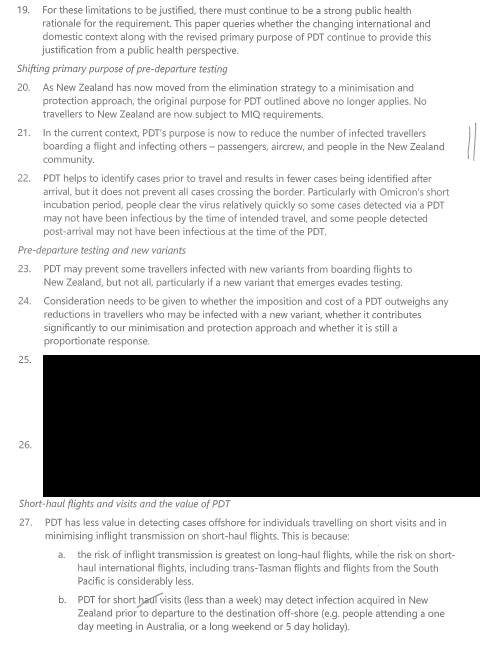
Document 4
Out of Scope
al Information Act 1982
Releas
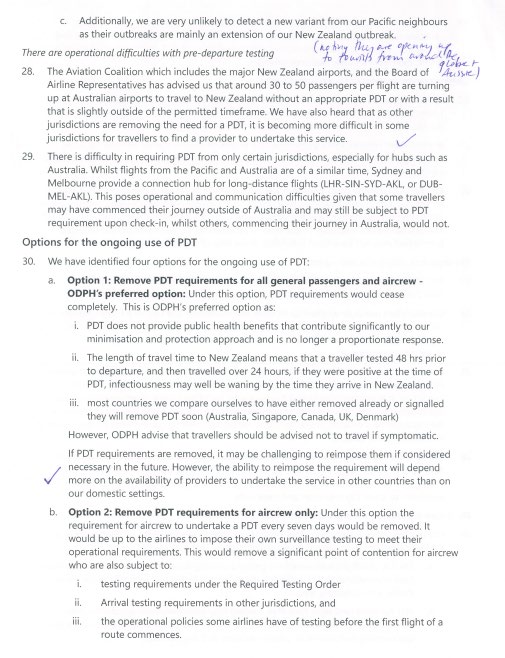
Document 4
1982
Act
Information
Official
the
under
Released
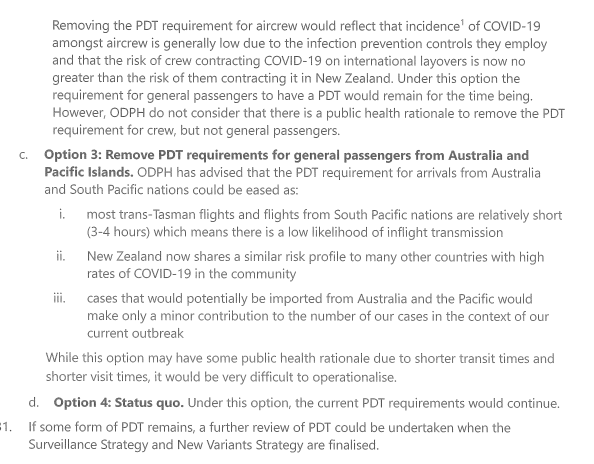
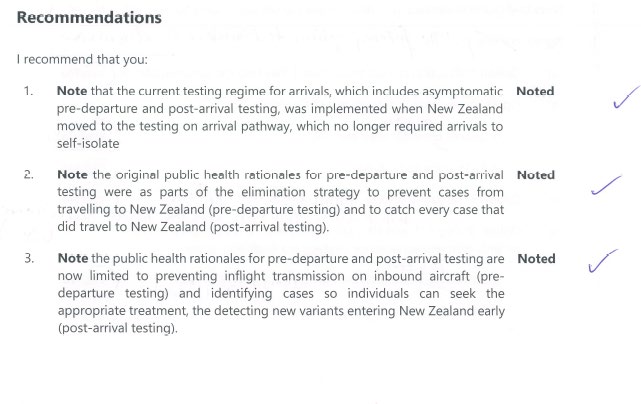
Document 4
1982
Act
Information
Official
the
under
Released
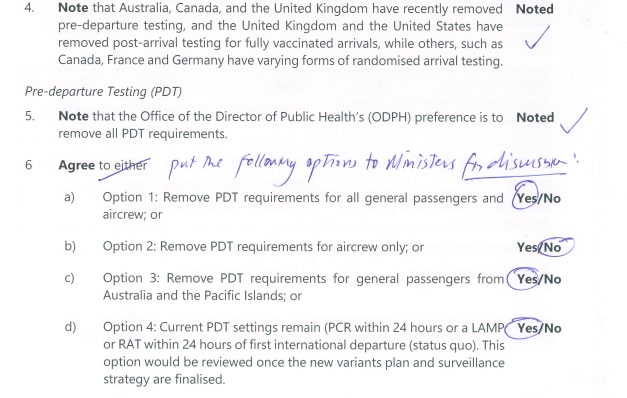
Document 4
1982
Act
Information
Official
the
under
Released










